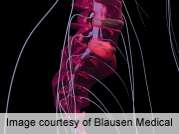In patients with lumbarized sacra, a lateral transpsoas surgical approach to the L5-6 disc space can be managed with appropriate preoperative planning, including axial magnetic resonance imaging and advanced neuromonitoring, according to a study published in the July issue of the Journal of Spinal Disorders & Techniques.
(HealthDay) -- In patients with lumbarized sacra, a lateral transpsoas surgical approach to the L5-6 disc space can be managed with appropriate preoperative planning, including axial magnetic resonance imaging (MRI) and advanced neuromonitoring, according to a study published in the July issue of the Journal of Spinal Disorders & Techniques.
William D. Smith, M.D., from the Western Regional Center for Brain and Spine Surgery in Las Vegas, and colleagues conducted a retrospective review involving 351 patients scheduled for lumbar interbody fusion using a mini-open lateral transpsoas approach at L4-5. Neuromonitoring was used to assess accessibility of the L5-6 level (functional L4-5) in patients with six lumbar vertebrae. Qualitative assessments based on MRI were compared with a sample of patients with normal anatomy treated at L4-5.
The researchers identified 10 patients (2.8 percent) with six lumbar vertebrae with the symptomatic level at L5-6. Two of these could be treated using a lateral transpsoas approach and eight were converted to a different approach after neuromonitoring feedback showed no corridor through the psoas muscle. In patients with transitional anatomy unapproachable at L5-6, axial MRI showed a teardrop-shaped psoas detached from the lateral border of the disc space, resembling L5-S1 in normal anatomy. In the two patients who could be treated with the transpsoas approach, the psoas anatomy at L5-6 was similar to that at a normal L4-5 level, with a domed/helmet shape laterally attached to the disc space.
"Treating the L5-6 level using a lateral transpsoas approach in individuals with lumbarized sacra can be challenging due to anatomy more similar to the L5-S1 level in normal patients," the authors write. "Preoperative planning using axial MRI and intraoperative adherence to advanced neuromonitoring can aid in identifying and avoiding injury in these rare patients."
More information:
Abstract
Full Text (subscription or payment may be required)
Copyright © 2012 HealthDay. All rights reserved.
























